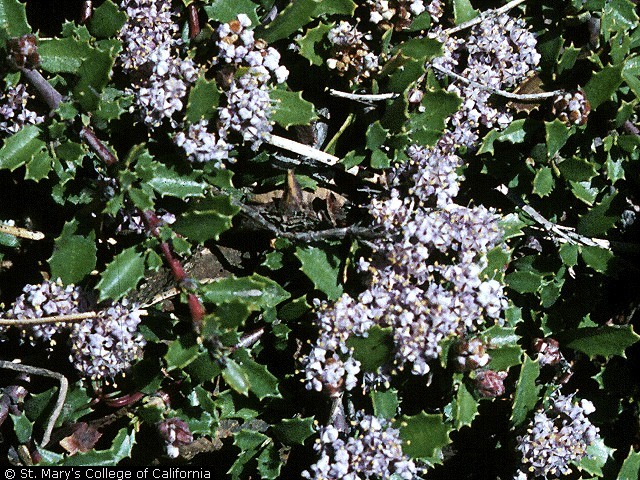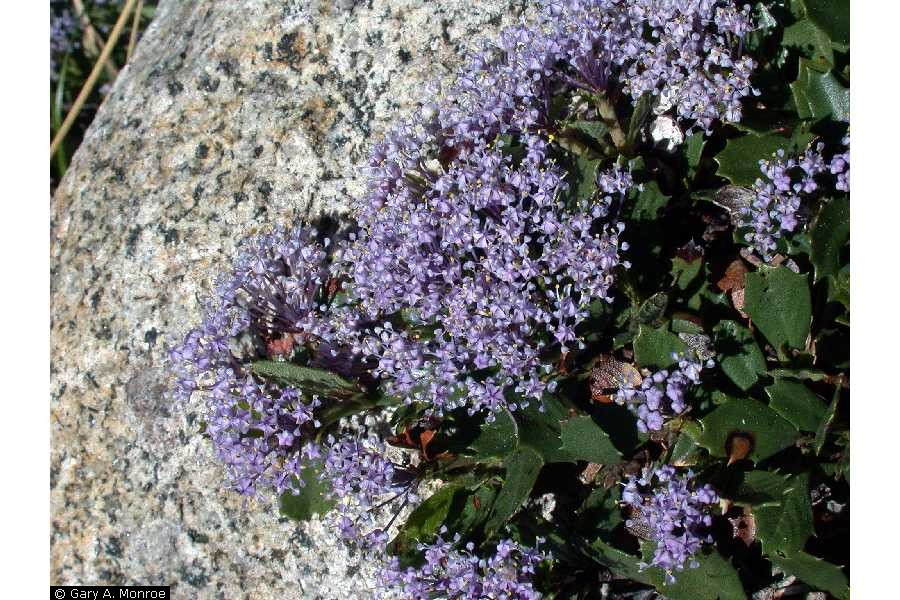 |
|
Brother Alfred Brousseau @ USDA-NRCS PLANTS Database |
 |
| Gary A. Monroe @ USDA-NRCS PLANTS Database |
Translate this page:
Summary
Physical Characteristics

 Ceanothus prostratus is an evergreen Shrub growing to 0.1 m (0ft 4in) by 1.5 m (5ft).
Ceanothus prostratus is an evergreen Shrub growing to 0.1 m (0ft 4in) by 1.5 m (5ft).
See above for USDA hardiness. It is hardy to UK zone 7. It is in flower from April to May. The species is hermaphrodite (has both male and female organs) and is pollinated by Bees.
It can fix Nitrogen.
Suitable for: light (sandy) and medium (loamy) soils and prefers well-drained soil. Suitable pH: mildly acid, neutral and basic (mildly alkaline) soils. It can grow in semi-shade (light woodland) or no shade. It prefers dry or moist soil.
UK Hardiness Map
US Hardiness Map
Synonyms
Plant Habitats
Woodland Garden Sunny Edge; Dappled Shade; Ground Cover;
Edible Uses
References More on Edible Uses
Medicinal Uses
Plants For A Future can not take any responsibility for any adverse effects from the use of plants. Always seek advice from a professional before using a plant medicinally.
None known
References More on Medicinal Uses
The Bookshop: Edible Plant Books
Our Latest books on Perennial Plants For Food Forests and Permaculture Gardens in paperback or digital formats.

Edible Tropical Plants
Food Forest Plants for Hotter Conditions: 250+ Plants For Tropical Food Forests & Permaculture Gardens.
More

Edible Temperate Plants
Plants for Your Food Forest: 500 Plants for Temperate Food Forests & Permaculture Gardens.
More

More Books
PFAF have eight books available in paperback and digital formats. Browse the shop for more information.
Shop Now
Other Uses
Dye Soap
A green dye is obtained from the flowers[168]. All parts of the plant are rich in saponins - when crushed and mixed with water they produce a good lather which is an effective and gentle soap[168, 169]. This soap is very good at removing dirt, though it does not remove oils very well. This means that when used on the skin it will not remove the natural body oils, but nor will it remove engine oil etc[K] The flowers are a very good source, when used as a body soap they leave behind a pleasant perfume on the skin[K]. The developing seed cases are also a very good source of saponins[K]. A useful ground cover plant, especially on warm sunny slopes[200].
Special Uses
Food Forest Ground cover Nitrogen Fixer
References More on Other Uses
Cultivation details
Prefers a warm sunny position but tolerates light shade[11, 200]. Tolerates some lime, but will not succeed on shallow chalk[200]. A difficult plant to cultivate, it might do well in a lime-free soil in full sun and occasionally does well on heavier soils[208]. This species is particularly susceptible to damage by frost when it is young[200], though it should be hardy as it grows older[11]. The sub-species C. prostratus occidentalis. McMinn. is a form growing by the coast in N. California - it may be a more suitable form for maritime areas[K]. Plants dislike root disturbance, they should be planted out into their permanent positions whilst still small[182]. Dislikes heavy pruning, it is best not to cut out any wood thicker than a pencil[182]. Plants flower on the previous year's growth, if any pruning is necessary it is best carried out immediately after the plant has finished flowering[200]. Constant pruning to keep a plant small can shorten its life[200, 219]. Fast growing, it flowers well when young, often in its second year from seed[11]. The branches are prostrate and often form roots where they touch the soil[11]. Hybridizes freely with other members of this genus[200]. Some members of this genus have a symbiotic relationship with certain soil micro-organisms, these form nodules on the roots of the plants and fix atmospheric nitrogen. Some of this nitrogen is utilized by the growing plant but some can also be used by other plants growing nearby[200, 212]. For polyculture design as well as the above-ground architecture (form - tree, shrub etc. and size shown above) information on the habit and root pattern is also useful and given here if available. An evergreen. A clumping mat former. Forming a dense prostrate carpet with a limited spread [1-2]. The root pattern is flat with shallow roots forming a plate near the soil surface [1-2].
References Carbon Farming Information and Carbon Sequestration Information
Temperature Converter
Type a value in the Celsius field to convert the value to Fahrenheit:
Fahrenheit:
The PFAF Bookshop
Plants For A Future have a number of books available in paperback and digital form. Book titles include Edible Plants, Edible Perennials, Edible Trees,Edible Shrubs, Woodland Gardening, and Temperate Food Forest Plants. Our new book is Food Forest Plants For Hotter Conditions (Tropical and Sub-Tropical).
Shop Now
Plant Propagation
Seed - best sown as soon as it is ripe in a cold frame. Stored seed should be pre-soaked for 12 hours in warm water and then given 1 - 3 months stratification at 1°c[138, 200]. Germination usually takes place within 1 - 2 months at 20°c[138]. one report says that the seed is best given boiling water treatment, or heated in 4 times its volume of sand at 90 - 120°c for 4 - 5 minutes and then soaked in warm water for 12 hours before sowing it[214]. It then requires a period of chilling below 5°c for up to 84 days before it will germinate[214]. The seed exhibits considerable longevity, when stored for 15 years in an air-tight dry container at 1 - 5°c it has shown little deterioration in viability[214]. The seed is ejected from its capsule with some force when fully ripe, timing the collection of seed can be difficult because unless collected just prior to dehiscence the seed is difficult to extract and rarely germinates satisfactorily[214]. Prick out the seedlings into individual pots as soon as they are large enough to handle. Grow them on in the greenhouse for at least their first winter and plant them out into their permanent positions in late spring or early summer. Cuttings of half-ripe wood, taken at a node[200], July/August in a frame[11]. Cuttings of mature wood of the current year's growth, 7 - 12 cm with a heel, October in a cold frame[78]. The roots are quite brittle and it is best to pot up the callused cuttings in spring, just before the roots break[78]. Good percentage.
Other Names
If available other names are mentioned here
Native Range
NORTHERN AMERICA: United States, California,
Weed Potential
Right plant wrong place. We are currently updating this section.
Please note that a plant may be invasive in one area but may not in your area so it's worth checking.
Conservation Status
IUCN Red List of Threatened Plants Status :

Growth: S = slow M = medium F = fast. Soil: L = light (sandy) M = medium H = heavy (clay). pH: A = acid N = neutral B = basic (alkaline). Shade: F = full shade S = semi-shade N = no shade. Moisture: D = dry M = Moist We = wet Wa = water.
Now available:
Food Forest Plants for Mediterranean Conditions
350+ Perennial Plants For Mediterranean and Drier Food Forests and Permaculture Gardens.
[Paperback and eBook]
This is the third in Plants For A Future's series of plant guides for food forests tailored to
specific climate zones. Following volumes on temperate and tropical ecosystems, this book focuses
on species suited to Mediterranean conditions—regions with hot, dry summers and cool, wet winters,
often facing the added challenge of climate change.
Read More
Expert comment
Author
Benth.
Botanical References
1160200
Links / References
For a list of references used on this page please go here
Readers comment
| Add a comment |
|
If you have important information about this plant that may help other users please add a comment or link below. Only comments or links that are felt to be directly relevant to a plant will be included. If you think a comment/link or information contained on this page is inaccurate or misleading we would welcome your feedback at [email protected]. If you have questions about a plant please use the Forum on this website as we do not have the resources to answer questions ourselves.
* Please note: the comments by website users are not necessarily those held by PFAF and may give misleading or inaccurate information.
To leave a comment please Register or login here All comments need to be approved so will not appear immediately.
|
Subject : Ceanothus prostratus
|
|
|
|